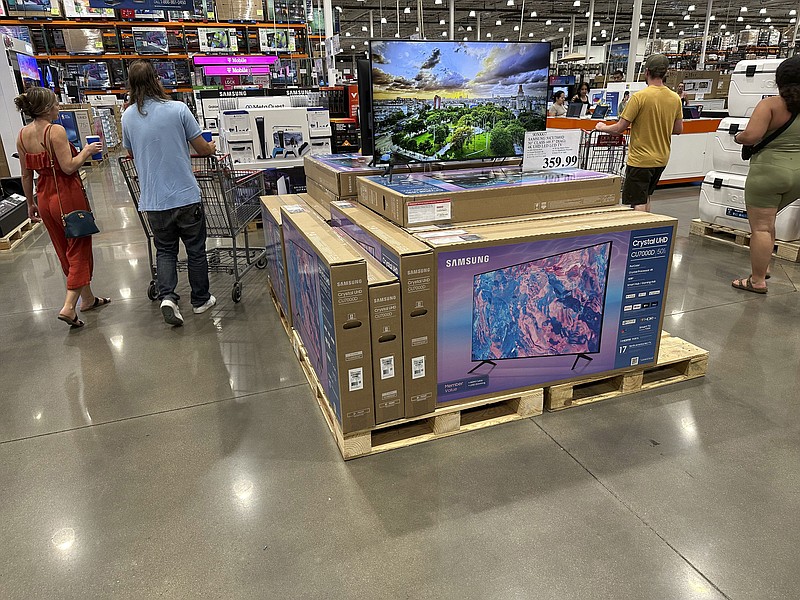By ANNE D'INNOCENZIO, PAUL WISEMAN and DEE-ANN DURBIN
AP Business Writers
NEW YORK (AP) -- Americans increased their spending last month as inflation eased in many areas, and the job market remained remarkably strong.
Retail sales rose 0.2% from May to June, following a revised 0.5% increase the previous month, the Commerce Department reported Tuesday.
The figure matched the pace of consumer inflation in June from the prior month, underscoring that shoppers are just about keeping up with pricing pressures. While the headline number of 0.2% was a bit weaker than expected, economists Tuesday focused on data that excludes volatile autos, gas, building materials and food services, which rose a solid 0.6% in June. That 0.6% figure is used to help calculate overall economic growth in the U.S., and it was a pretty strong showing in June.
Shoppers increased spending at electronic stores and furniture and home furnishings stores after a recent pullback. Online sales also had a solid increase. But sales at grocery stores, gas stations and sporting goods stores fell. At restaurants, sales eked out a tiny increase.
The uptick in sales follows an increase in May that pointed to an economy that remains resilient despite rising prices. Yet spending has been volatile this year after surging nearly 3% in January. Sales tumbled in February and March before recovering in April and May.
"While they continue to spend, the June retail sales report suggests that consumers are becoming more thoughtful with their purchases," wrote Oren Klachkin, U.S economist at Oxford Economics. He pointed to the labor market losing some momentum, declining savings, and interest rates that have made borrowing money or using credit cards more expensive.
There is already early evidence of a pushback from consumers that is being reflected in financial reports from some of the country's biggest food producers.
Consumers, whose spending accounts for about 70% of all U.S. economic activity, have been the engine behind the economic recovery from a slowdown during the pandemic. Government relief checks, the suspension of student loan payments and super-low interest rates helped.
Demand outpaced what factories could produce and what ports and freight yards could handle, leading to shortages, delays -- and skyrocketing prices.
That gave companies "abnormal power to push up prices" and pass higher costs along to consumers -- clout they hadn't had for decades, Simon MacAdam, senior global economist at Capital Economics, wrote last month.
That dynamic has shifted, however.
Low interest rates are long gone: The Federal Reserve began aggressively hiking rates in March 2022. The student loan moratorium -- which allowed Americans to divert money that used to go to loan payments to dinners out and new furniture -- ends later this year.
And the savings that Americans had stashed away at the peak of the pandemic -- when they were receiving government relief checks and saving money while hunkered down at home -- are vanishing. Fed researchers have reported that consumers depleted their excess' savings in the first three months of 2023.
All of which means that consumers may no longer be willing -- or able -- to tolerate elevated prices as overall inflation dips.
U.S. data on prices, the most recent arriving last week, showed that consumer inflation reached its lowest point since early 2021 last month. Prices rose just 0.2% from May to June thanks to easing costs for gasoline, airline fares, used cars and groceries. Inflation is just up 3% over the last 12 months. But Americans still face surging prices for some goods and services as well, like auto insurance.
Ryan Dixon, who recently moved from Florida to a farm in Hillsboro, Tennessee, said he didn't notice prices increasing as much in 2020 and 2021 because of the COVID-19 relief payments he was getting from the government. But as that money ran low, it became clear that he needed to find new ways to cut spending.
Now, he keeps track of the coupons in the Target and Walmart apps, scours the grocery aisles for deals on meat and buys store-brand canned goods.
"I'm not buying Del Monte and Green Giant anymore. I'm buying the Walmart brand," he said.
There are a handful of brands he loves and won't substitute, like his Mountain Dew sodas. But he is looking for cheaper alternates almost everywhere else.
"I never thought I would shop like my mother," Dixon said. "But if I don't have a coupon for it, I don't get it."
Those kinds of every day decisions are beginning to show up in the financial performance of major food producers.
Conagra Brands, which makes Slim Jim beef jerky, Duncan Hines cake mix and more, said during a fourth-quarter earnings call last week that smaller price increases have not translated to higher sales volume. That is a quick turn from the third quarter when price increases ---- which topped 15% that quarter ---- did not dent demand.
"It's not a trade down within individual categories to lower-priced alternatives. It looks, optically, more like a cutting back and what I call hunkering down," Conagra CEO Sean Connolly told analysts. "And one thing I know for sure, people aren't eating less. So they're making choices to manage their budget."
